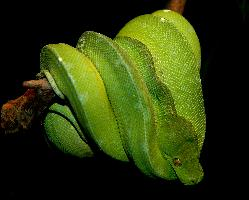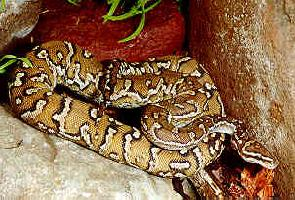
Weights and measures
| Length | 160 cm |
|---|
Animal description
The Green Tree Python (Morelia viridis) is a captivating and highly sought-after species within the reptile enthusiast community, renowned for its striking coloration and unique arboreal lifestyle. Originating from the lush rainforests of New Guinea, islands in Indonesia, and Cape York Peninsula in Australia, this species thrives in a humid, tropical environment, spending the majority of its life gracefully draped over tree branches.Adult Green Tree Pythons typically reach lengths of about 150 to 180 cm (5 to 6 feet), though some individuals may grow larger. They possess a slender, muscular body adapted for an arboreal existence, with a prehensile tail that aids in gripping branches securely. The head is relatively small and distinctly marked from the neck, with a row of thermoreceptive labial pits below and between the scales around the mouth, which they use to detect warm-blooded prey in the darkness of their canopy homes.
One of the most remarkable features of the Green Tree Python is its vibrant coloration. Juveniles are born with a striking coloration that can range from bright yellow, red, or even a deep maroon, depending on their geographical origin. This vivid coloration serves as effective camouflage among the foliage and flowers of their habitat, helping to protect them from predators. As they mature, their coloration undergoes a dramatic transformation, generally around one to two years of age, settling into the brilliant green that gives the species its common name. This green can vary in shade and may be accentuated with patterns of blue, yellow, or white. The purpose of this color change is not fully understood, but it is believed to play a role in camouflage within their predominantly green arboreal environment.
Green Tree Pythons are strictly carnivorous, preying on a variety of small mammals and birds. They employ a sit-and-wait strategy, remaining motionless for long periods before striking with remarkable speed and precision when prey ventures within reach. They are non-venomous and kill their prey through constriction, coiling their bodies tightly around the victim until suffocation occurs.
Reproduction in Green Tree Pythons is oviparous, with females laying clutches of 10 to 25 eggs. The female exhibits maternal care, coiling around the eggs to protect them and regulate their temperature through muscular contractions until they hatch after approximately two months. Hatchlings are independent from birth and receive no further care from the mother.
Despite their fierce appearance, Green Tree Pythons are generally shy and reclusive, preferring to avoid confrontation. When threatened, they may coil into a tight ball with their head in the center, hiss, or even strike. However, with proper handling and care, they can become more tolerant of human interaction.
In captivity, Green Tree Pythons require specialized care to thrive, including appropriate temperature gradients, high humidity, and ample vertical space to accommodate their arboreal nature. They are popular among experienced reptile enthusiasts for their stunning appearance and fascinating behavior but are not recommended for beginners due to their specific care requirements.
Conservation-wise, the Green Tree Python is currently not considered to be at risk. However, habitat destruction and the pet trade pose potential threats to their populations. Sustainable practices and responsible pet ownership are crucial to ensuring that this magnificent species continues to thrive in the wild and in captivity.
Similar Animals
New photos of animals
Top 10 animals
- Dolphin gull (Leucophaeus scoresbii)
- Diana monkey (Cercopithecus diana)
- Moustached guenon (Cercopithecus cephus)
- Galápagos tortoise (Geochelone nigra complex)
- Japanese macaque (Macaca fuscata)
- Stone loach (Barbatula barbatula)
- Russian tortoise (Testudo horsfieldii)
- Greek tortoise (Testudo graeca)
- Common flying dragon (Draco volans)
- Vendace (Coregonus albula)


